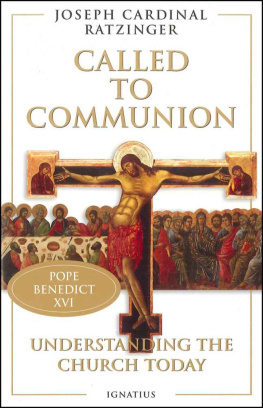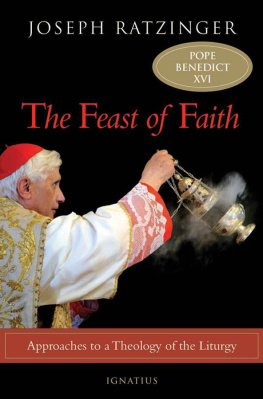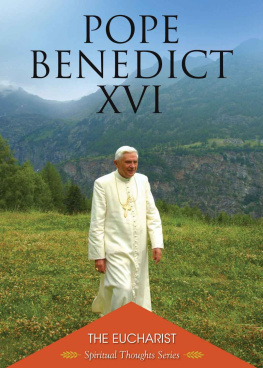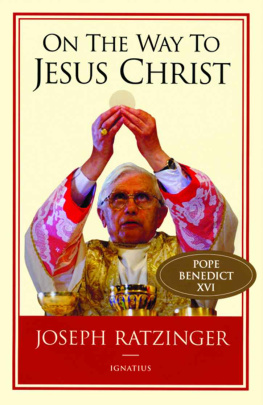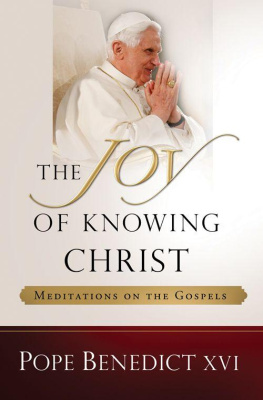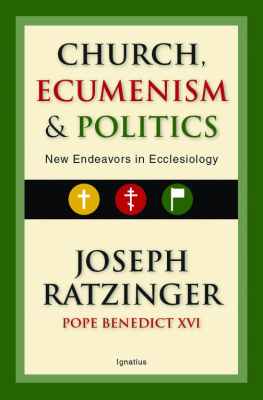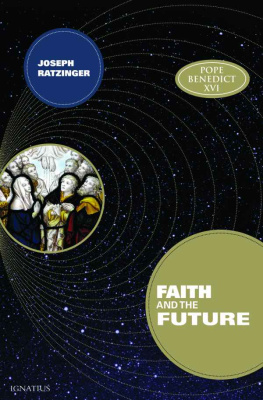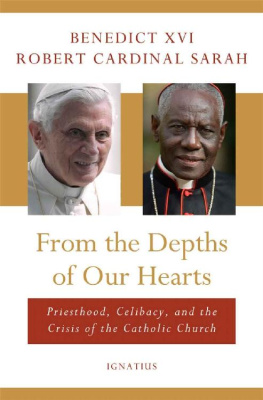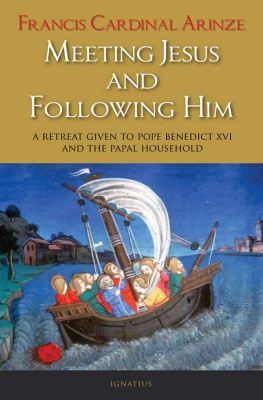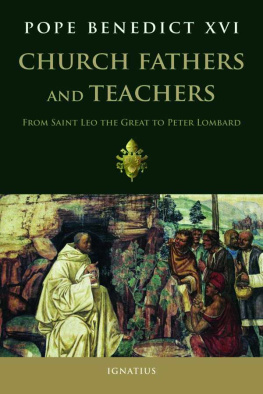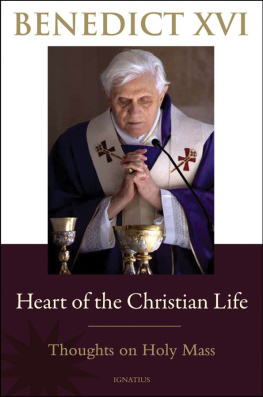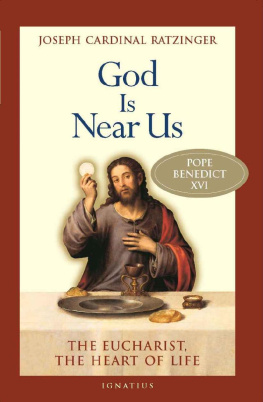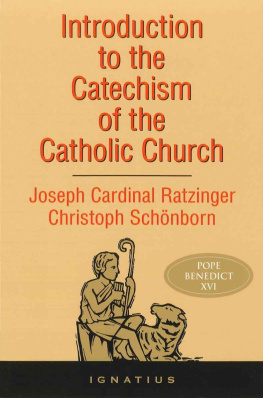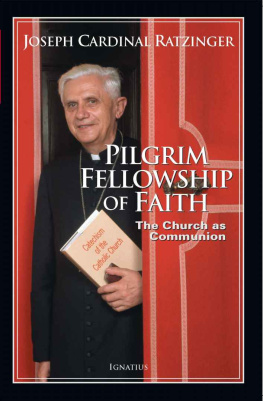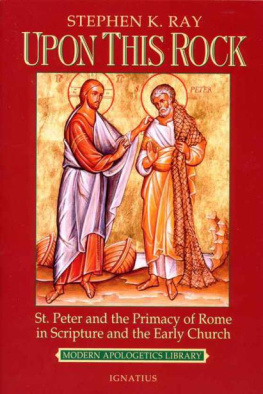CALLED TO COMMUNION
JOSEPH CARDINAL RATZINGER
Called to
Communion
Understanding the Church Today
TRANSLATED BY
ADRIAN WALKER
IGNATIUS PRESS SAN FRANCISCO
Title of the German original:
Zur Gemeinschaft gerufen: Kirche heute verstehen
second edition, 1991 Herder, Freiburg im Breisgau
Cover design by Roxanne Mei Lum
Cover art: Scala / Art Resource, New York
(Left panel): Duccio. The Last Supper (detail)
Museo dell Opera Metropolitana, Siena, Italy.
(Center): Cimabue. Crucifixion (detail)
San Domenico, Arezzo, Italy.
(Right): Duccio. Pentecost (detail)
Museo dellOpera Metropolitana, Siena, Italy.
1996 Ignatius Press, San Francisco
All rights reserved
ISBN 0-89870-578-9
Library of Congress catalogue number 95-79953
Printed in the United States of America
Contents
a. Jesus and the Church
b. The Churchs self-description as
c. The Pauline doctrine of the Church as the Body of Christ
a. The mission of Peter in the whole of New Testament tradition
b. Peter in the group of the Twelve according to synoptic tradition
c. The commission logion: Matthew 16:17-19
a. The principle of succession in general
b. The Petrine succession in Rome
Preliminary consideration:
The problems
Foreword
Today the question of the Church has to a large extent become the question of how the Church can be changed and ameliorated. Yet even someone who wishes to improve upon a mechanical device, and all the more someone who wants to heal an organism, must first investigate how the apparatus is designed or how the organism is inwardly structured. If doing so is not to prove blind and thereby destructive, it must be preceded by inquiry about being. Today as always, the will to take action in regard to the Church must find the patience first to ask about her nature, her origin, her destination; today as always, ecclesial ethos can develop properly only when it allows itself to be illuminated and led by the logos of faith.
In this spirit, the five chapters of this book attempt to offer a sort of primer of Catholic ecclesiology. The first three chapters were written for a theology course in Rio de Janeiro that drew a gathering of around a hundred bishops from every quarter of Brazil between the twenty-third and the twenty-seventh of July 1990. The principal question concerned the relationship between the universal Church and the particular Church, with special regard to the primacy of the successor of Peter and its relation to the ministry of the bishops. The brotherly atmosphere that reigned during those days together became almost without any effort of ours a concrete interpretation of the assigned topic. We were favored with a delightful experience of catholicity with its living interplay of unity and plurality; I hope that for its part the written word can still convey something of the spirit in which we lived and worked together and in this way help toward a renewed understanding of the Church.
To these three chapters I have added the address that I presented at the opening of the Synod of Bishops on the priesthood in October 1990 as an introduction to the synodal consultations on priestly formation. Furthermore, my talk on the Church and ecclesial reform, which concluded the annual meeting at Rimini on September 1, 1990, has been incorporated into this volume. These additions were meant to give the problem of the existence and structure of the Church a needed breadth beyond the vision of the Rio conferences, whose horizon was defined primarily in terms of the episcopal office. At the same time, they were intended to link this problem to contemporary questions touching the life of the Church. It was likewise the lively public reaction provoked by these two texts that made their inclusion in this volume seem appropriate. A homily that I preached in January 1990 at the seminary in Philadelphia attempts by way of conclusion to clarify once more the spiritual orientation of the whole book. I hope that this small volume can bring clarity and help in the crisis of ecclesial consciousness through which we are now living.
JOSEPH CARDINAL RATZINGER
Rome, on the Feast of
the Epiphany, 1991
I
The Origin and Essence of the Church
I. Preliminary considerations on method
The questions that occupy todays discussion of the Church are mostly of a practical nature: What is the responsibility of the bishop? What is the significance of the particular Churches in the whole of the Church of Jesus Christ? What is the raison dtre of the papacy? How should the bishops and the pope, the particular Church and the universal Church work together? What is the status of the layman in the Church? In order to be able to respond correctly to these practical problems, we must premise the fundamental question: What is the Church in the first place? What is the purpose of her existence? What is her origin? Did Christ actually will her, and, if so, how did he intend her to be? Only if we are able to reply properly to these basic questions do we have any chance of finding an adequate answer to the particular practical problems mentioned above.
Yet the very question about Jesus and the Church, as well as about the initial form of the Church in the New Testament itself, is so overgrown by the tangled thicket of exegetical hypotheses that there is seemingly next to no hope of finding any sort of adequate answer to it. There thus exists the dangerous temptation to pick out the solutions that appear most congenial or else to skip over the problem entirely in order to plunge immediately into practical matters. But this sort of pastoral ministry would be founded upon skepticism; we would, should we adopt it, no longer be attempting to follow the Lord but would be groping about blindly toward what appeared attainable to us: we would become blind men leading the blind (cf. Mt 15:14).
A way through the primeval forest of exegetical hypotheses can be found as long as we do not simply force our way in at random with a machete. For by doing so we become entangled in a constant struggle with the various theories and, despite every effort, in the end remain entrapped in their contradictions. Instead, what is needed first of all is a kind of aerial photograph of the whole: when our gaze ranges over a larger expanse of terrain, it is also possible to find our bearings. Hence, we must follow the course of exegesis for about a hundred years; it is then that we will spot its major windings and discover what could be called the directional currents along which it has developed. In this way we will learn to discern straight paths from detours. If we attempt such an aerial photographic survey, we can distinguish three generations of exegetes and, corresponding to these, three great principal changes in the history of biblical interpretation in our century. At the beginning of this history stands liberal exegesis, which regards Jesus according to the liberal world picture as the great individualist who liberates religion from cultic institutions and reduces it to ethics, which for its part is founded entirely upon the individual responsibility of conscience. Such a Jesus, who repudiates cultic worship, transforms religion into morality and then defines it as the business of the individual, obviously cannot found a church. He is the foe of all institutions and, therefore, cannot turn around and establish one himself.
The First World War brought with it the collapse of the liberal world and a resulting aversion to its individualism and moralism. The great political bodies, which had relied entirely on science and technology as carriers of the progress of humanity, had failed as forces of ethical order. So the yearning for communion in the sacred was reawakened. There was a rediscovery of the Church, even in the domain of Protestantism. Scandinavian theology witnessed the development of a cultic exegesis, which, in strict antithesis to liberal thought, no longer saw Jesus as a critic of cultic worship but rather understood this worship as the intimate, vital atmosphere of the Bible, in both the Old and the New Testament. Such exegesis, therefore, also attempted to interpret Jesus words and intentions themselves in the light of the great stream of the lived liturgy. Similar tendencies appeared in the English-speaking world. But even in German Protestantism, a new sense of Church had arisen: there was a growing awareness that the Messiah is unthinkable without his Church. After the Second World War, humanity was divided ever more sharply into two camps: into a world of affluent peoples, who for the most part were once more living according to the liberal model, and into the Marxist block, which conceived of itself both as the spokesman of the poor nations of South America, Africa and Asia and as their model for the future. Correspondingly, there arose a twofold division of theological tendencies.
Next page
